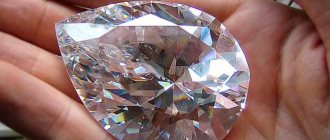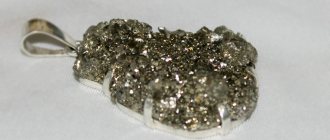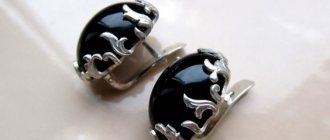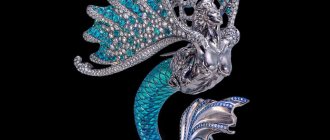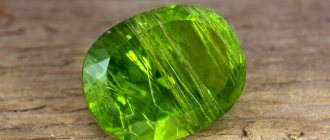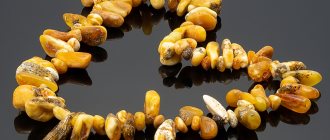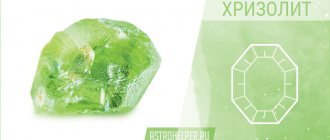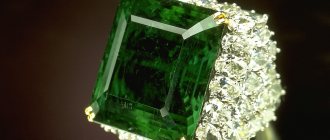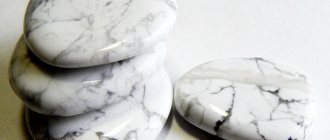Olivine is an amazing mineral, the name of which is synonymous with chrysolite. At all times, people have attached great importance to this stone. Our ancestors considered the green inclusions of the mineral as something extraordinary, and therefore attributed a large number of interesting properties to it. Even now, the gem has not lost its meaning: it is used by lithotherapists, magicians and esotericists.
Olivine is also called the golden stone, and is therefore compared to the endless energy of the sun. Representatives of ancient civilizations believed that this positive energy was transmitted to a person and healed him. Below we will consider in detail the healing and magical properties of olivine stone.
Olivine formula
(Mg,Fe)2[SiO4]
Olivine
one of the most common minerals of the island silicate subclass. It is an intermediate member of the isomorphic series of minerals forsterite Mg2[SiO4] - fayalite Fe2[SiO4].
Altered, limonitized olivines are described under the names: sideroclepte (Sosyur, 1794), chusite (Sosyur, 1794), limbilite (Sosyur, 1794); serpentinated: steatoid—• steatoid (Glocker, 1839), villarsite—villarsite (Dufrenois, 1842), matricite—matricite (Holst, 1875). Altered olivine is also glinkite (Romanovsky, 1847) and ferrite (Yang, 1882). Ferrifayalite (Ginsburg et al., 1962) is an altered fayalite.
Chemical composition
Mg and Fe replace each other without limit.
Theoretical composition of olivine: a) at Mg/Fe=2: MgO—37.94, FeO—33.80, Si02—28.26; b) at Mg/Fe=l: MgO—23.41, FeO—41.71, SiO2—34.88.
In nature, magnesium olivines—forsterite and olivine itself—are the most common. Much less common are olivines of intermediate composition up to Fa57 (hortonolite), as well as ferruginous ones - Fa100-88 (ferrogornotolite). The composition of the mineral often varies somewhat within the same rock and at different intrusion horizons. Variations in the composition of olivine of different generations are also observed (higher Fe content in late olivine), and an increase in the iron content of olivine in basaltic flows (from early to late) is also noted.
Mg and Fe are isomorphically replaced by Mn, Ni, Co, Ca. The Mn content in ferruginous olivines is higher (up to 5% MnO) [110] than in magnesian ones. Fayalite contains varying amounts of MnO and is a connecting link of two isomorphic series: forsterite - fayalite and fayalite - tephroite. The NiO content is generally insignificant; Nickel is found predominantly in magnesian olivines. Forsterite (Fa3-6) from chromite ores of the Kempirsay massif in the Southern Urals contains on average 0.62% NiO, while in olivine from dunites and harzburgites of the same massif (Fa6-9) there is only 0.30 and 0.26 NiO; in Yakut magnesian olivines the maximum NiO content is 0.05. A greater amount of Ni, as well as Cr, was found in the olivine of melilite basalts than in typical German basalts. The Ni content in olivine is lower than in the associated sulfides and higher than in the associated pyroxenes. Characteristic is the almost complete absence of Ni in olivine from meteorites. For both Ni and Co, a correlation is established with the Mg content, but the amount of CoO is usually significantly less than NiO; Olivines from Yakut kimberlites contain no more than 0.08% CoO; up to 0.032 CoO was found in olivines of ultramafic rocks of Azerbaijan. For magnesian olivines, an insignificant chromium content is often noted (in the mineral from Yakut kimberlites, Cr2O3 is up to 0.48%). The CaO content in olivines is usually very low; it increases slightly with increasing manganese content.
Spectral and partly chemical analyzes often show the presence of various elements, the nature of which, however, is not specified by the authors. Not in all cases there is confidence in the purity of the material selected for study. The Sc content is noted: in forsterite from pyroxenites of the Tagil-Baranchinsky massif of the Urals 0.0003-0.0009% Sc2O3, in olivine from the alkaline-ultrabasic massifs of the Kola Peninsula and Karelia 0.0003-0.0005%.
Ga was found in olivine from hypermafic rocks of the Urals, from alkaline-ultrabasic massifs of the Kola Peninsula, from basalts of Silesia; According to Ivanov, different olivines contain 1-5 g/m Ga. In olivine from the island of Linosa (Pelagian Islands), containing about 42% MgO and 11-12% FeO, according to Carobbi, lead (0.2% PbO) was found.
Chrysolite. Crystal fragments
TR is observed in very small quantities only in olivines from Yakut kimberlites. Limits for the content of other elements in g/m: In—0.02–0.06, Ge—1.3–2.1, Cd up to 0.37, Tl up to 0.11. Olivine from the Eifel (Germany) contains 0.25–0.8 g/m Be. Uranium is found in olivine from eclogites forming inclusions in kimberlites of Yakutia (0.021–0.043 g/t U); in mineral from dolerite-monzonites of the trap formation of Kuzbass (U—1.0-10-6%), from meimechite of Siberia (10.2-10_4%). Fayalite from Primorye contains: Rb2O—0.09, Cs2O—0.07, Li2O—0.10%; in olivine (Fa18) from hypermafic rocks of the Urals Li 0.0002%. The presence of Pb, Cs, Li, Sr, Ba and Cu was established in minerals from Skaergaard, Cu - in olivine from Silesian basalts.
In olivine of unknown composition and paragenesis, 1-10-6% Ar was noted (it is indicated that the absolute age values for olivine obtained using the K-Ar method are overestimated).
Varieties
Chrysolite - chrysolite - transparent, greenish-yellow and green olivine. Chrysolite is a precious and ornamental stone.
Peridot is a gem quality olivine.
Synonym Gawait (gawaiit) - hawaiite (Elshner, 1906); The chrysolite is presumably Dostokan, a green colored gemstone. In jewelry, the name peridot is also used.
The most famous peridots are from Zeberget near the Red Sea (SAR), where large crystals occur; the length of the largest is more than 4.5 cm and weighs over 69 g. Peridot from some deposits in the USA is also used (Webster and Belzem in North Carolina). Good crystals, cut resembling the Ural demantoid, are known in Mongolia. Gem-quality olivine is found in some kimberlite pipes of Yakutia; in the Udachnaya pipe the content of chrysolite is 19 g/m3.
Crystallographic characteristics
Rhombic syngony Rhombo-bipyramidal class. D2h—mmm (3L23PC).
Form of being in nature
Continuous fine-grained masses. Ural
The appearance of crystals.
Crystals of various shapes are mostly short-prismatic, elongated along the c axis, often tabular along 6(010), rarely along a(100). Sometimes the crystals are elongated along the a-axis; An unusual elongation according to [101] was noted for olivine crystals forming inclusions in diamond (accordingly, they have an oblique extinction). Crystals of pseudohexagonal development are observed. Kalb and Koch identified three types of crystals:
1) “Sasbach type”, characteristic of phenocrysts in basic rocks;
2) “Monzoni type” - in contact-metamorphic formations;
3) “Triblitz type” - the latest crystals of pneumatolytic origin (mainly fayalite);
These types, however, do not exhaust the variety of olivine crystals found in nature. In meteorites - pallasites, the crystals of the mineral are round. Skeletal crystals are quite common. Skeletal development is also characteristic of olivine crystals in slags. Vertical hatching is often observed on the a (100) faces. On the surface of olivine crystals from Yakut kimberlites, peculiar pyramids, cone-shaped mounds and ribbed surfaces were noted, interpreted as figures of partial dissolution.
Twins according to (011) and according to (031) are common; they are twins of germination; they are relatively rare; even less often - tees; Twins at (012), at (120) and at (110) were also noted. According to Burri, twins are predominantly observed in olivine crystals from rocks enriched in calcium (ancaratrites, melilite basalts, etc.). Twins are found relatively more often in slag olivine: in synthetic fayalite, only (011) twins were observed.
Aggregates. Olivine usually occurs in the form of granular masses or individual grains included in the rock.
Compatibility with zodiac signs
Astrologers have long been studying the compatibility of the mineral with zodiac signs. The experts concluded that:
- The energetic power of the mineral is suitable for Virgos. People will be directed to the true path, they will be able to develop and improve themselves. Under the influence of the stone, Virgos will accumulate the necessary skills and establish relationships with others. Representatives of this sign will be able to build romantic relationships.
- The stone is also suitable for Pisces, helps in increasing self-esteem, and gets rid of complexes. Under the influence of the mineral, Pisces learn to make decisions and cope with life's difficulties. Representatives of this sign will learn to defend their point of view.
- Olivine suits Leo. The gem develops leadership qualities and helps in achieving success. Leos learn to avoid conflicts and problems.
- It is better for Capricorns not to use the power of the mineral, since their energy will conflict.
Inclusions in olivine
Inclusions in olivine grains are very diverse. In the early olivine of gabbro-dolerites of the Norilsk region (Fa14-25), inclusions of plagioclase, pyroxene, sulfides, also glass and gas bubbles or essentially gas inclusions were noted; in later olivine (Fa36-4o to Fa56-60) there are only glass inclusions and poikilitic intergrowths of plagioclase and early olivine. Inclusions of glass and gas were also observed in olivine phenocrysts from nepheline basalts of the Bakony massif (Hungary). Glass inclusions, according to Johnston, are characteristic of skeletal forsterite crystals from lavas and small intrusions. Inclusions of liquid carbon dioxide were also noted. There are frequent inclusions of magnetite (the result of the decomposition of a solid solution), spinel, pyroxenes, plagioclases, also chromite, and sometimes perovskite. Myrmekite intergrowths of olivine with titanomagnetite, with pyroxenes, etc. are known. Oriented intergrowths with ilmenite are described: the a axis (elongation axis) of olivine crystals is parallel to the c axis of ilmenite, also (010) and [001] of olivine (0001) and [1120] of ilmenite [ 59], in intergrowths with magnetite (010) and [100] olivine || (111) and [PO] magnetite [59]. Regularly oriented inclusions of olivine in diamonds are observed: most often (010) and [101] olivine || (111) and [101] diamond, less commonly (001), [110] and [100] olivine (001), [011] and [011] diamond and (100), [010], [001] olivine (001) , [011], [011] diamond; also [101] olivine ||(111) diamond. Antigorite leaflets are often oriented parallel to (010), (100), (102) olivine. In olivine gabbros and norites, in gabbro-monzonites and other rocks, rims (kelyphitic rims) of hornblende, monoclinic or rhombic pyroxenes are often observed near olivine grains. Spinel, plagioclase, garnet, etc. are often found in such rims.
Physical properties
Optical
- The color, depending on the composition, can vary from olive green and light yellow to bottle green, bottle brown and black (the black color of olivine is due to the development of serpentine along numerous microcracks).
- The line is missing. The powder is white, yellowish, greenish-gray.
- The luster is glassy, to metallic on the cleavage plane.
- The tide is oily.
- Transparency Translucent to translucent
Mechanical
- Mineral hardness 6.5-7
- The density of olivine is 3.2 - 3.5. It increases in a mineral with increasing iron content.
- Cleavage along (100) and (010) is distinct to perfect (due to the presence in the structure of the densest packing parallel to (100) and chains along the c axis. It manifests itself to varying degrees, in general it is better in olivines with a higher content of the fayalite molecule.
- The fracture is uneven, sometimes conchoidal
- fragile
Artificial production of mineral
. Olivine is formed by heating chlorites at temperatures of about 800°. Magnesian olivine crystallizes from fused basalt glasses in the temperature range from 1200 to 1145°. The limits of miscibility and stability of Mg2SiO4 and Fe2SiO4 have been studied in many systems. Data on the MgO - FeO - SiO2 system, first studied by Bowen and Schairer, have been refined several times; The system FeO - MgO - CaO - SiO2 has been studied. The systems forsterite - albite, forsterite - diopside - anorthite, fayalite - magnetite, etc. have been studied. Olivine of various compositions is found in technical products - in refractory and ceramic materials and in slags.
Diagnostic signs
Diagnostics.
Difficult to recognize.
Diagnosed by color, shine, shape of aggregates. Single crystals are similar in appearance to fragments of bottle glass. An important diagnostic feature is the frequent development of more noticeable minerals along olivine - talc and fibrous serpentine (chrysotile asbestos). Similar minerals: diopside, epidote. The difference is that diopside has a lower hardness (5.5-6) and perfect cleavage, while epidote has a peculiar yellow-green (pistachio-green) color and average cleavage.
It is distinguishable from the outwardly similar (sometimes) apatite by its biaxiality and significantly higher refractive indices; from monoclinic pyroxenes - by the absence in thin sections of intersecting cleavage cracks characteristic of pyroxenes and by direct extinction; sometimes difficult to distinguish from rhombic pyroxenes, in particular from hypersthene, in thin sections (birefringence is slightly higher). The absence of anomalous interference coloring and cleavage cracks characteristic of epidote serves to distinguish olivine from epidote.
Satellites. Pyroxenes, basic plagioclases, magnetite; in altered rocks – serpentine, talc, calcite, dolomite; does not occur together with quartz (with the exception of fayalite, which is rare in nature).
Medicinal properties
The beneficial qualities of the stone were known several centuries ago. The mineral has a beneficial effect on the body. Olivine will improve vision if a person looks at it for a long time. Crushed stone helps with itchy eyes. Residents of Vietnam use olivine to treat liver diseases.
In what cases is the gem effective:
- Restoration of the central nervous system.
- Elimination of malfunctions in the cardiovascular system.
- Facilitating the birth process.
- Assistance in the treatment of gynecological diseases.
- Regulation of metabolic processes in the body.
- Healing of wounds and abrasions.
- Improving potency.
- Elimination of frequent headaches and migraines.
- Sleep stabilization.
- Restoring the body after a recent stroke.
- Help for multiple sclerosis.
Experts recommend wearing a pendant with olivine to newborn babies. The stone will protect the baby from diseases and fill it with positive energy. Lithotherapists believe in the healing power of the mineral, which can be aimed at restoring the emotional background. Olivine eliminates attacks of anger, aggression, fights jealousy and feelings of dissatisfaction. Supporters of traditional medicine advise applying the mineral to sore spots.
Practical use
Chrysolite.
Crystals cut into cabochons Low-iron olivine rocks can be used as refractory raw materials. Peridot and peridot are precious stones.
Rocks consisting mainly of magnesian olivine are used to produce silicate technical glass.
Peridot and chrysolite are gem-quality minerals used in cutting.
Magic of stone
Who is olivine stone suitable for? The gem patronizes strong and weak individuals. If a person constantly faces failures, the stone will help achieve success and protect against difficulties. The mineral is able to guide the owner on the right path. The magical properties of a gem can impart secret knowledge to a person.
